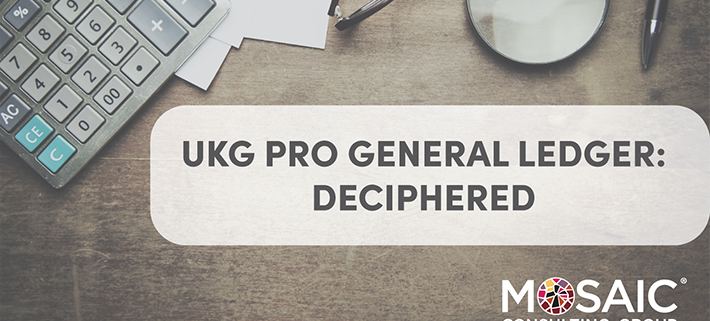UKG Pro General Ledger (GL): Deciphered
UKG Pro contains General Ledger functionality that captures payroll transactions and outputs them into a file formatted for import into your company’s financial system. When implemented and configured correctly, this GL function can eliminate or reduce manual manipulation of the data — which in turn reduces human error and improves compliance. Auditors love this type of automation, and your team will too! An optimized GL will allow your team to focus on bigger tasks, by freeing up time and improving efficiency.
GL: What It Is, Why It’s Important
Companies record their financial activity in a General Ledger (GL). This General Ledger is used for financial reporting, planning and compliance. GL affects every department within your company. From an HR and Payroll standpoint, GL is used for payroll recording as well as any forecasting and planning.
Scroll down to the end of this post to review our GL Glossary.
What causes GL challenges?
During your UKG Pro launch, or implementation, your GL will be configured. This includes setting up Organization Levels, GL Rules, and the GL export file and/or reports. (see our glossary at the bottom of this post for full definitions on these and other concepts).
During this initial configuration it is important to consider:
- Finance, Payroll and HR: GL rules define how transactions are mapped and affect all three departments. If only one department is involved in the decision-making process; it’s possible that something will get missed, forcing another department to manipulate the data they receive. All departments should be part of the conversation.
- Translations: Finance, payroll and HR departments don’t speak the same language! Each discipline has different words for similar concepts; for example, Departments versus Cost Centers. UKG Pro allows you to translate these words in a way that all departments will have the information they need at the end of each payroll.
- Prepare for change: Consider where your company is now and where it is going. As you grow, so must your GL rules and tables. Your team should think strategically while implementing your system. Make sure to have your tables reviewed periodically to ensure that they still work the way you need them to for your current organizational structure.
So, what now?
At the end of the GL Process, you will have access to a GL Export File. This file, configured within UKG Pro, contains the required data for your financial system. If someone on your team is spending time manipulating this data, that is a sign that something needs to be optimized within your system.
The GL rules within UKG Pro are so configurable that they should work FOR you. Although it is not an accounting software, UKG Pro has the functionality, out of the box, to simplify your processes and make sure your data is clean and transferable across all departments.
If you believe you need a GL Review or have questions about how to optimize your system’s functionality, feel free to contact us today.
GL Glossary:
Components of UKG Pro GL configuration:
- GL Base Account: The GL Base Account codes are used as the fixed portion of your General Ledger (GL) account number.
- GL Segment Sequence: GL account numbers consist of cost center information, base accounts, and constant values that are unique to your accounting system. These components are referred to as segments of the general ledger. Segment Sequences are sections linked together to form the GL account number. Your company defines which components are valuable for reporting, budgeting, and analysis.
- GL Rules: The GL Rules defines how payroll transactions are mapped and reported on the GL export file or GL reports. Mapping components on the GL Rules table include the GL Type Code, Payroll code (earning, deduction, or tax), base account, and segment sequence.
GL Export File:
An export template is configured in UKG Pro to allow the export of payroll data required for the financial system. The export extracts its data from the General Ledger/Labor Allocations table. The resulting GL file includes the sum of debit and credit amounts by general ledger (GL) account number.
Organization (Org) Levels
Org levels in UKG Pro are typically used to classify employees based on a specific group for the purpose of reporting and/or GL posting. Examples of classification types include:
- Cost Centers
- Business Units
- Region.
GL Type Code – each type of payroll transactions is identified with a GL Type Code. The GL Type Code will assist with troubleshooting items that may appear on the GL Suspense Detail report.
| GL Type Code | |||
| GL Type Code | General Ledger Code Description | Debit | Credit |
| EE | Earnings expense | Debit | |
| DE | EE Deduction payable | Credit | |
| TE | EE Taxes payable | Credit | |
| NC | EE Net pay checks | Credit | |
| ND | EE Net pay direct deposit | Credit | |
| TR | ER Taxes expense | Debit | |
| TL | ER Taxes liability | Credit | |
| DR | ER Deduction expense | Debit | |
| DL | ER Deduction liability | Credit | |
GL Suspense Detail report – this report is generated after the GL process is run. If all payroll items are mapped on the GL Rules table, this report will be blank. If items exist on this report, the GL Rules table must be updated to map that code. Once mapped, the GL Process must be re-run.
Labor Allocations and the Auto Allocate feature are not necessarily part of GL and although commonly are used; they may not be used by every company. They are included in this list because they will affect the GL file.
- Labor Allocations allow you to automatically or manually allocate your employees’ earnings and hours worked to cost centers such as departments, divisions, or projects.
- The Auto Allocate feature allocates all employees’ wages according to a percentage, not specific time worked. This method is typically used for auto paid employees. Labor allocations for hourly employees can also be defined using the manual allocation method (such as through a time clock import)
If you believe you need a GL Review or have questions about how to optimize your system’s functionality, feel free to contact us today.




